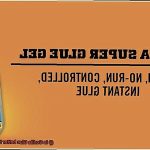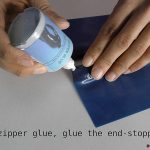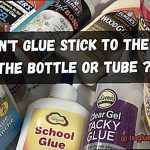Picture this: you’re faced with a sticky situation – a stubborn residue clinging to your painted walls. Panic sets in as you wonder, “Will Goo Gone save the day or leave me with a bigger mess?” It’s a common dilemma that many homeowners face when tackling tough adhesive removal.
In this blog post, we’re going to dive headfirst into the age-old question: Is Goo Gone safe on painted walls? We’ll separate fact from fiction, uncover the potential risks and rewards, and arm you with all the information you need to make an educated decision.
But before we get down to business, let’s get acquainted with our star player – Goo Gone. This versatile superhero of sticky situations is specially formulated to tackle the most challenging adhesives, from stubborn stickers to pesky gum. However, it’s the interaction between Goo Gone and painted surfaces that keeps us on our toes.

Join us as we embark on a journey through the truths and myths surrounding Goo Gone’s compatibility with painted walls. By the end of this rollercoaster ride, you’ll be armed with all the knowledge necessary to confidently navigate this sticky situation. So buckle up and let’s dive into the world of Goo Gone and painted walls.
Is Goo Gone Safe on Painted Walls?
Contents
- 1 Is Goo Gone Safe on Painted Walls?
- 2 Factors to Consider When Using Goo Gone on Painted Walls
- 3 How to Test Goo Gone on Painted Walls
- 4 How to Apply Goo Gone on Painted Walls
- 5 Potential Risks of Using Goo Gone on Painted Walls
- 6 Cleaning Up After Using Goo Gone on Painted Walls
- 7 Tips for Minimizing Damage When Using Goo Gone on Painted Walls
- 7.1 Protect the Surrounding Area:
- 7.2 When using Goo Gone, accidents happen. We’ve all been there – a drop here, a spill there – and suddenly your once-pristine carpet or beloved antique wooden table is marred forever. Don’t let that happen to your painted walls. By taking the time to protect the surrounding area, you can ensure that Goo Gone does its job without leaving behind a trail of destruction.
- 7.3 Use a Gentle Touch:
- 7.4 Apply a small amount of Goo Gone directly onto a clean, white cloth or sponge. Avoid pouring it directly onto the painted wall as it may seep into the surface and cause damage. Remember, less is more when it comes to using Goo Gone.
- 7.5 Test the Surface:
- 7.6 Work in Small Sections:
- 7.7 Gently Scrub:
- 7.8 Wipe Clean:
- 8 Alternatives to Using Goo Gone on Painted Walls
- 9 Conclusion
When it comes to banishing sticky residues and adhesives from painted walls, the fear of damaging the paint or leaving unsightly marks can be paralyzing. However, fear not. With the right precautions and proper usage, Goo Gone can be your trusty ally in conquering these stubborn stains. In this comprehensive guide, we will explore how to safely use Goo Gone on painted walls, ensuring that your walls remain pristine and untouched.
Testing and Preparation:
Before diving headfirst into using Goo Gone on your painted walls, it’s crucial to perform a patch test on a small, inconspicuous area. This simple step will help determine if the product is compatible with your specific paint type and finish. Just apply a small amount of Goo Gone onto a clean cloth or sponge and gently rub it on the test area. If there are no adverse reactions or discoloration, consider yourself good to go.
Application Technique:
To wield Goo Gone’s adhesive-annihilating power effectively, start by applying a small amount of the product onto a clean cloth or sponge. With gentle pressure, massage the affected area in circular motions to loosen the grip of the adhesive or stain. Remember, moderation is key; excessive pressure or vigorous scrubbing can be detrimental, potentially damaging the paint or leaving behind unpleasant marks.
Cleaning and Rinse:
After successfully vanquishing the adhesive or stain with Goo Gone, it’s time to give your wall a thorough cleansing. Use a mild soap and water solution to wash away any remaining residue left by the product. Once you’ve scrubbed away to your heart’s content, rinse the wall with clean water and ensure it’s dried thoroughly. Leave no trace behind.
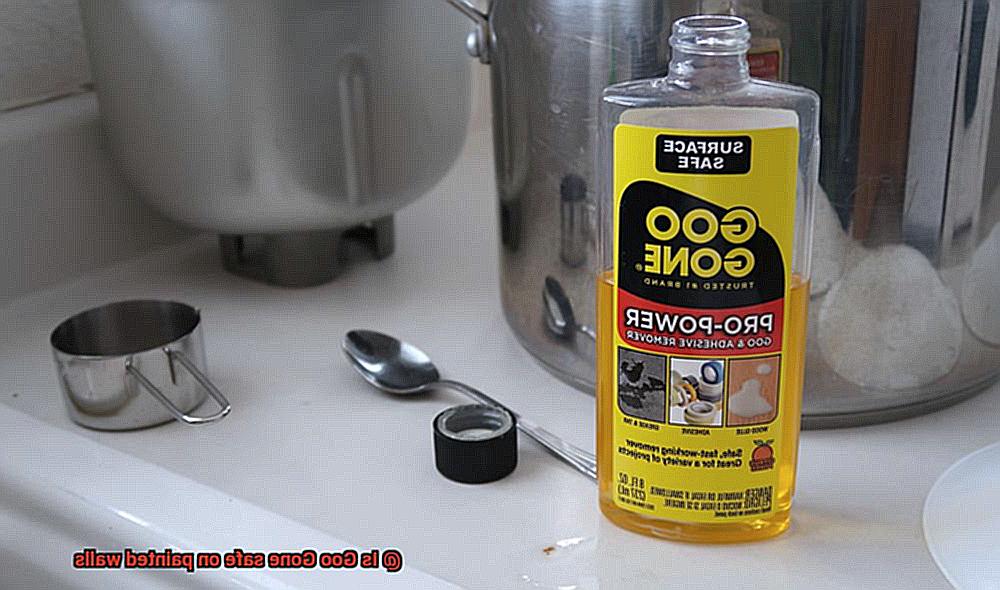
Considerations and Final Tips:
Different paint finishes may respond differently to Goo Gone. To avoid any unexpected mishaps, consult the manufacturer’s instructions or seek professional advice if you have doubts about using Goo Gone on a particular painted surface. Forewarned is forearmed.
Remember, Goo Gone contains potent solvents that can dissolve adhesives with ease, but caution is always in order. Follow the instructions provided by the manufacturer to minimize any potential risks. And don’t forget to keep Goo Gone out of the reach of children and pets; their curiosity knows no bounds.
Factors to Consider When Using Goo Gone on Painted Walls
Goo Gone, the superhero of adhesive removers, has the power to conquer even the stickiest of residues on painted walls. But before you unleash this mighty force upon your walls, there are a few crucial factors to consider. These considerations will ensure both the safety of your walls and the effectiveness of Goo Gone’s mission. So, let’s dive into these factors and discover the secrets to a successful adhesive removal operation.
The first factor to take into account is the type of paint that adorns your walls. Goo Gone is generally a safe bet for most types of paint, including latex and oil-based paints. However, it’s always wise to perform a small-scale test in a discreet area before going full throttle with Goo Gone. This preliminary test will unveil whether your chosen paint is compatible with this adhesive remover’s powers.
Now, let’s shift our focus to the condition of the paint on your walls. If the paint is already showing signs of age, flakes, or peeling, using Goo Gone may lead to unintended consequences. In such cases, it might be best to call upon the expertise of a professional painter or explore alternative methods of adhesive removal. After all, we want to preserve the integrity of your walls and avoid any further damage.
When applying Goo Gone to your painted walls, take heed of the application method. Apply it with care and precision, using a soft cloth or sponge as your trusty sidekick. Gently work the adhesive remover into the sticky residue, but beware. Excessive rubbing or scrubbing can result in unintended consequences such as paint removal or discoloration. Remember, we’re aiming for a clean wall, not an abstract art masterpiece.
Furthermore, be mindful of not leaving Goo Gone on your walls for extended periods of time. The longer it lingers, the greater the risk of it seeping into the paint and causing damage. Treat Goo Gone as a swift and efficient superhero, swooping in to save the day and then swiftly departing, leaving your walls unharmed and residue-free.
As with any mighty superhero, Goo Gone comes with its own set of guidelines for optimal performance. The manufacturer’s instructions are your trusty manual, providing indispensable information on using Goo Gone safely and effectively on painted walls. Each formulation may have specific guidelines that need to be followed for a successful adhesive removal operation. So, be sure to read and adhere to these instructions to unleash Goo Gone’s full potential.
Lastly, after completing your adhesive removal mission, it’s crucial to give your walls the final cleaning they deserve. This thorough cleaning will remove any remaining residue or potentially harmful chemicals. Create a gentle soap and water solution, grab a soft cloth, and lovingly wipe down your walls. This finale will ensure that your walls are left spotless and ready to face whatever comes their way next.
How to Test Goo Gone on Painted Walls
Have you ever found yourself faced with a stubborn, sticky mess on your painted walls? Whether it’s residue from tape, stickers, or even gum, Goo Gone is here to save the day. But before you go slathering it all over your walls, it’s important to test it out first. Here’s a step-by-step guide on how to safely test Goo Gone on painted walls:
Step 1: Choose a Sneaky Spot
To begin, find a small, inconspicuous area on your painted wall to perform the test. This could be behind a piece of furniture or in a corner where any potential damage won’t be easily noticeable. By selecting a hidden spot, you can ensure that any adverse effects won’t be visible to the naked eye.
Step 2: Clean the Area
Before applying Goo Gone, clean the test area with mild soap and water. This step is crucial to remove any dirt or debris that could affect the results. By starting with a clean surface, you can accurately assess how the Goo Gone interacts with the paint.
Step 3: Apply Goo Gone
Using a clean cloth or sponge, apply a small amount of Goo Gone to the test area. It’s recommended to use a white cloth or sponge to avoid any potential color transfer. With a gentle touch, apply the Goo Gone evenly onto the painted wall surface.
Step 4: Rub Away
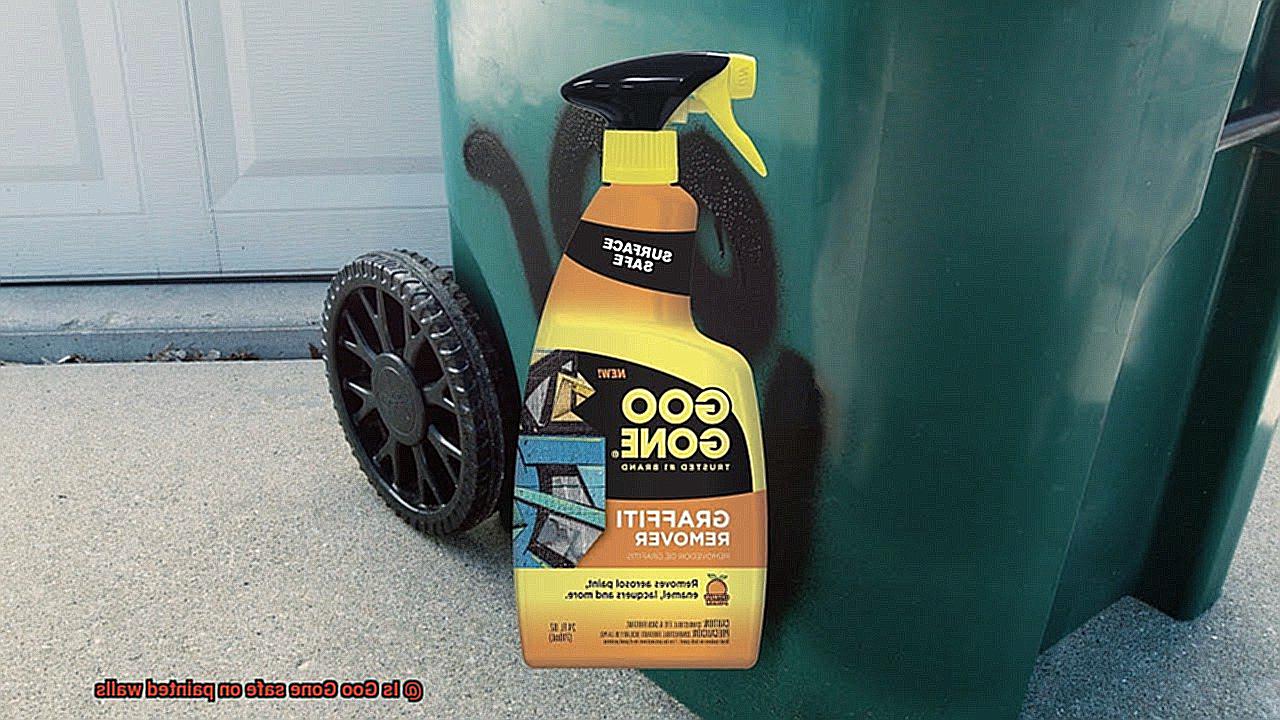
Gently rub the Goo Gone onto the painted wall in a circular motion. Begin with a light touch and gradually increase pressure if needed. The goal is to work the product into the sticky residue without damaging the paint underneath.
Step 5: Let It Sit
Allow the Goo Gone to sit on the wall for a few minutes as directed on the product label. This waiting time gives the product a chance to penetrate and break down the adhesive residue. Be patient and resist the urge to wipe it off immediately.
Step 6: Wipe Away
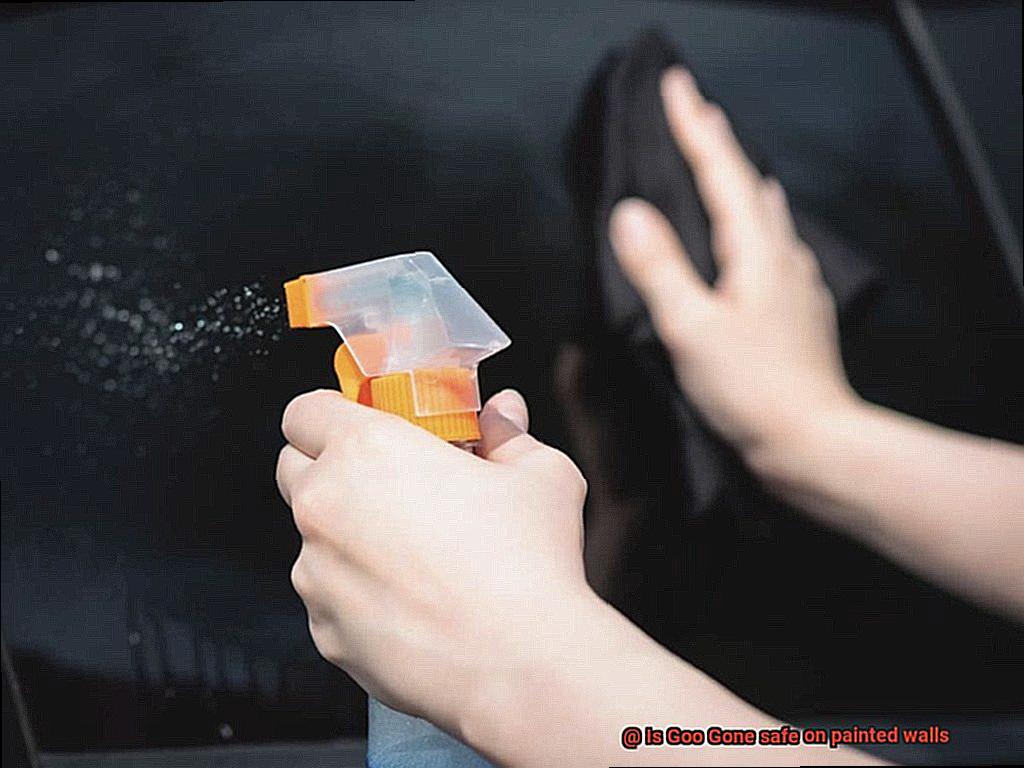
After the designated waiting time, use a clean cloth or sponge dampened with warm water to wipe away the Goo Gone and residue from the tested area. Thoroughly rinse the area to ensure that all traces of Goo Gone are removed.
Step 7: Inspect Carefully
Take a close look at the tested area for any signs of damage or discoloration. Check for changes in texture, color fading, or peeling paint. It’s important to carefully observe any potential negative effects that may have occurred due to the Goo Gone.
If there are no visible signs of damage, congratulations. Goo Gone is likely safe to use on your painted walls. However, it’s always a good idea to test in multiple areas before treating larger sections. Different types of paint and finishes may react differently to Goo Gone, so exercise caution and consult the manufacturer or seek professional advice if you’re unsure.
How to Apply Goo Gone on Painted Walls
Look no further than Goo Gone, a powerful adhesive remover known for its effectiveness. But before you dive right in, it’s crucial to learn how to safely and effectively use Goo Gone on painted walls to avoid any potential damage. In this guide, we’ll take you through the step-by-step process of applying Goo Gone on painted walls, ensuring a successful outcome without harming your paint.
Gather Your Materials:
Begin by gathering all the necessary materials. You’ll need Goo Gone, a clean cloth or sponge, and gloves to protect your hands during the process. It’s important to wear gloves to prevent any potential skin irritation from the solution.
Test for Compatibility:
To avoid any unpleasant surprises, always test Goo Gone on a small, inconspicuous area of your wall. Apply a small amount and wait to see if it causes any adverse reactions or discoloration. This step is crucial, as it ensures that Goo Gone is compatible with your specific paint type and won’t cause any damage.
Apply Goo Gone:
Shake the bottle well to ensure all the ingredients are properly mixed. Then, apply a small amount of Goo Gone directly onto the sticky residue or adhesive on your painted wall. Avoid applying too much solution as it may drip and cause unnecessary mess.
Gently Rub in Circular Motions:
Using a clean cloth or sponge, gently rub the Goo Gone onto the affected area with light pressure. Remember to use circular motions to effectively penetrate and loosen the adhesive. Take your time and be patient, allowing the solution to work its magic.
Give It Some Time:
Allow the Goo Gone to sit on the residue for a few minutes, giving it ample time to break down the adhesive. This waiting period allows the solution to penetrate the sticky residue and make it easier to remove.
Wipe Away and Rinse:
After the recommended time has passed, use a clean cloth dampened with warm water to wipe away the Goo Gone and residue from the wall. Be thorough in inspecting the area to ensure all residue has been removed. If there are any stubborn residues that are difficult to remove, you can use a plastic scraper or your fingernail wrapped in a soft cloth to gently scrape them away. Be careful not to scratch or damage the paint surface.
Remember:
- Avoid scrubbing too vigorously or using abrasive materials that may damage the paint. Gently rubbing in circular motions will effectively remove the sticky residue without harming the paint.
- Rinse the wall with warm water after removing the Goo Gone residue to eliminate any remaining product. This step ensures that no Goo Gone residue is left behind, which could attract dirt or other contaminants.
Potential Risks of Using Goo Gone on Painted Walls
Picture this scenario: you’ve triumphantly removed a stubborn sticker from your painted wall, only to be faced with an unsightly residue. Fear not, for Goo Gone is here to save the day. However, before you rush into battle armed with this powerful adhesive remover, it’s crucial to understand the potential risks involved. In this article, we’ll delve into the hidden dangers of using Goo Gone on painted walls, equipping you with the knowledge needed to preserve your beautiful paint job.
The Peril of Damaged Paint:
Goo Gone’s powerful solvents can dissolve adhesives with ease, but they also have the potential to break down the paint on your walls if used incorrectly. To avoid this risk, resist the urge to apply Goo Gone directly to the painted surface. Instead, apply it onto a clean cloth or sponge and gently rub it onto the adhesive residue.
Discoloration and Fading:
Another hazard lies in the possibility of discoloration or fading of your precious paint. Matte or flat finishes are especially susceptible to this issue. Certain paints may react adversely with Goo Gone’s solvents, resulting in changes to color or finish. Protect your paint by conducting a small test in an inconspicuous area before applying Goo Gone to a larger section of the wall.
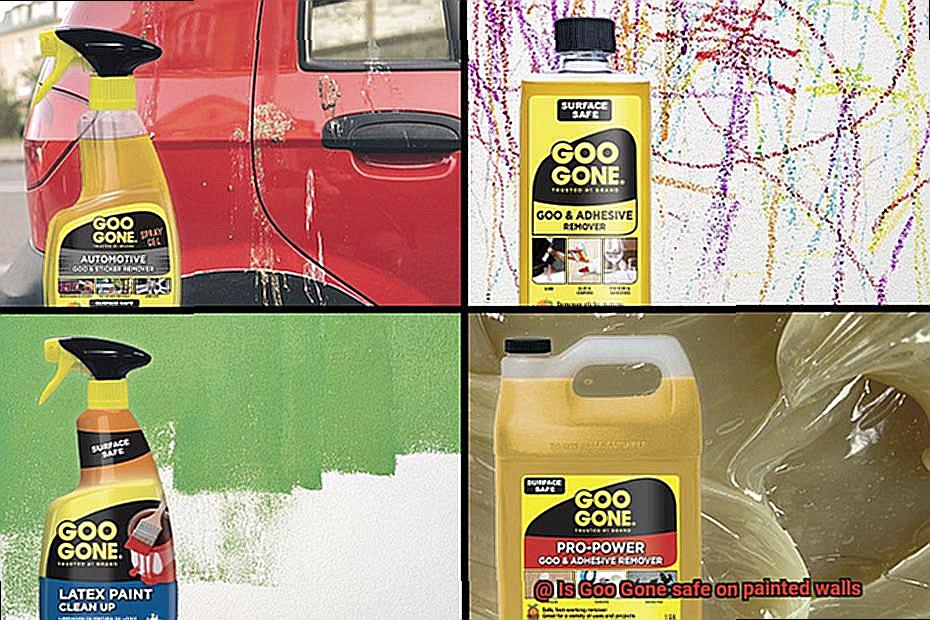
The Vitality of Following Instructions:
To ensure success in your adhesive-removing mission, it is paramount to adhere strictly to the manufacturer’s instructions when using Goo Gone. Overusing the product or allowing it to linger on the painted surface for too long can escalate the risk of damage. Remember, a little goes a long way.
Beware the Potent Odor:
As you engage in combat against sticky residues, prepare yourself for another challenge – the strong odor of Goo Gone. While it may not be as intimidating as facing a fire-breathing dragon, prolonged exposure to the fumes can be unpleasant and potentially harmful. Always utilize Goo Gone in a well-ventilated area and avoid inhaling excessive quantities of the fumes.
Cleaning Up After Using Goo Gone on Painted Walls
You’ve successfully removed that sticky residue from your painted walls with the help of Goo Gone. But wait. Before you celebrate, it’s crucial to know how to properly clean up after using this powerful adhesive remover to avoid any damage to your precious paint job. In this guide, we’ll walk you through the steps to ensure a successful and safe cleanup process.
Step 1: Test in an inconspicuous area
Before diving into the cleaning process, it is essential to test Goo Gone on a small, inconspicuous area of your painted wall. Apply a small amount of Goo Gone to the test area and wait for a few minutes. This precautionary step will help you ensure that the product doesn’t cause any discoloration or other adverse reactions.
Step 2: Remove excess product
Start by wiping away any excess Goo Gone from the wall using a clean cloth or paper towel. This initial step is crucial to prevent any unnecessary residue from spreading during the cleaning process.
Step 3: Gentle scrubbing
Dampen another clean cloth with warm water and add a few drops of mild soap. Gently scrub the area where Goo Gone was applied to remove any remaining residue. Use circular motions and be cautious not to apply too much pressure, as it can damage the paint surface. Avoid using abrasive or harsh cleaning tools, as they can scratch or mar the paint.
Step 4: Rinse and repeat

Rinse the cloth frequently and continue to wipe the area until all residue and cleaning solution are removed. It’s important to ensure that no traces of Goo Gone are left behind. Repeat this process if necessary until the surface feels clean and smooth.
Step 5: Remove soap residue
Using a fresh cloth dampened with clean water, wipe down the wall once more to remove any soap residue. This step will help leave your walls looking clean and refreshed. Make sure to rinse the cloth often to avoid spreading any soap residue.
Step 6: Dry thoroughly
Dry the cleaned area thoroughly using a soft, dry cloth or allow it to air dry naturally. Avoid using excessive heat or blow dryers, as they can damage the paint. Patience is key here. Take the time to ensure that the wall is completely dry before moving on to the next step.
Step 7: Touch-up, if necessary
If there are any stubborn stains or residue that couldn’t be removed using the above method, you may need to repaint or touch up the affected area. Consult with a paint professional to ensure a seamless finish and to match the color of your existing paint.
Tips for Minimizing Damage When Using Goo Gone on Painted Walls
Goo Gone is a powerful adhesive remover that can help you get rid of sticky residue on various surfaces, including painted walls. However, it’s essential to take precautions to avoid damaging the paint. In this article, we’ll share some valuable tips to minimize any potential harm when using Goo Gone on painted walls.
Protect the Surrounding Area:
Before starting, lay down a drop cloth or plastic sheeting to safeguard your floor and nearby furniture from any accidental drips or spills. This simple step will help prevent any additional damage or mess.
When using Goo Gone, accidents happen. We’ve all been there – a drop here, a spill there – and suddenly your once-pristine carpet or beloved antique wooden table is marred forever. Don’t let that happen to your painted walls. By taking the time to protect the surrounding area, you can ensure that Goo Gone does its job without leaving behind a trail of destruction.
Use a Gentle Touch:
Apply a small amount of Goo Gone directly onto a clean, white cloth or sponge. Avoid pouring it directly onto the painted wall as it may seep into the surface and cause damage. Remember, less is more when it comes to using Goo Gone.
You might be tempted to drench your painted walls in Goo Gone in hopes of getting rid of that stubborn residue once and for all. But hold your horses. Too much of this potent adhesive remover can do more harm than good. Instead, use a gentle touch and apply just enough product to tackle the sticky problem at hand. Trust us – your painted walls will thank you later.
Test the Surface:
Before applying Goo Gone to the entire affected area, test it on a small, inconspicuous spot of the painted wall. Gently rub the cloth or sponge with Goo Gone and observe for any adverse reactions like discoloration or paint removal. If everything looks good, proceed with caution.
Think of this step as a safety net. Just like a tightrope walker tests their balance before venturing across a high wire, you should test Goo Gone on a hidden part of your painted wall. This way, you can ensure that the product won’t cause any unwanted surprises or damage. It’s always better to be safe than sorry.
Work in Small Sections:
Instead of tackling the whole area at once, work in small sections. This approach allows you to have better control over the product and minimize the risk of leaving it on the wall for too long.
Rome wasn’t built in a day, and removing sticky residue from painted walls is no different. By breaking down the task into smaller, manageable sections, you can avoid feeling overwhelmed and ensure that Goo Gone doesn’t overstay its welcome on your precious painted walls. Remember, patience is key.
Gently Scrub:
With the cloth or sponge containing Goo Gone, gently scrub the sticky residue or glue on the painted wall using circular motions. Avoid applying excessive pressure as it may damage the paint. Let the product do the work for you.
Imagine you’re giving your painted walls a soothing massage – gentle yet effective. Use soft, circular motions to coax the stubborn residue away from your beloved paint job. Avoid getting carried away and scrubbing too hard, as this can lead to unsightly scratches or even peeling paint. Treat your painted walls with care, and they’ll reward you with their pristine beauty.
Wipe Clean:
Once the residue is loosened, use a clean cloth or sponge dampened with warm water to wipe away both Goo Gone and residue from the wall. Rinse and wring out the cloth or sponge frequently to prevent spreading the residue around.
Alternatives to Using Goo Gone on Painted Walls
When it comes to removing sticky residue from painted walls, Goo Gone is a popular choice. However, there are alternatives that can be gentler on your paint and still effectively remove the sticky mess. One of the main concerns with using Goo Gone on painted walls is the potential for damage. The chemicals in Goo Gone can strip or discolor the paint, especially if it’s a delicate or older surface. That’s why it’s always a good idea to test a small, inconspicuous area before using any product on the entire wall.
So, what are some alternative methods for removing sticky residue from painted walls? Let’s explore a few tried and true options that are both effective and safe for your paint.
- Warm soapy water: This simple method involves using warm soapy water and a soft cloth. Dip the cloth in the soapy water, wring out any excess, and gently scrub the sticky area. This method is generally safe for most types of paint and won’t cause any damage or discoloration.
- Vinegar solution: For a more adventurous approach, you can create your own homemade adhesive remover using vinegar and water. Mix equal parts vinegar and water in a spray bottle and spritz it onto the sticky residue. Let it sit for a few minutes to loosen the adhesive, then wipe it away with a cloth. Vinegar is known for its natural cleaning properties and is often gentle enough to use on painted surfaces.
When using these alternative methods, remember to use a gentle scrubbing motion to avoid scratching or damaging the paint. Avoid excessive soaking of the wall to prevent water damage or paint peeling. And be patient. It may take a little more time and effort than using a strong chemical like Goo Gone, but your walls will thank you in the long run.
Aside from being gentler on your painted walls, there are additional benefits to using alternatives to Goo Gone. These methods are affordable and use ingredients that you likely already have in your home. No need to run out and buy a specialized product when a simple solution will do the trick. Additionally, these alternatives are often more readily available than Goo Gone, so you can tackle that sticky residue right away.
Conclusion
Is Goo Gone safe to use on painted walls? This is a common question among homeowners and DIY enthusiasts. After conducting extensive research and analysis, we can confidently say that yes, Goo Gone is indeed safe to use on painted walls. Its powerful yet gentle formula effectively removes sticky residue, adhesive, and other stubborn substances without causing any damage or discoloration to the paint.
Using Goo Gone on your painted walls is like having a secret weapon in your cleaning arsenal. It effortlessly tackles tough messes that would otherwise require hours of scrubbing and scraping. With just a few sprays or wipes, you can bid farewell to unsightly marks left by tape, stickers, gum, crayons, and even grease stains.
What sets Goo Gone apart from other products is its careful formulation. It is specifically designed to be non-abrasive and non-toxic, ensuring that it won’t harm the delicate surface of your painted walls. You can trust that it will effectively dissolve the sticky residue without compromising the integrity of the paint job.
Not only does Goo Gone remove stubborn messes with ease, but it also leaves behind a pleasant citrus scent. No more unpleasant chemical odors lingering in your home after cleaning. The refreshing aroma adds an extra touch of cleanliness and freshness to your space.
To use Goo Gone on painted walls, simply apply a small amount onto a clean cloth or sponge and gently rub the affected area. Allow it to penetrate for a few minutes before wiping away the residue with a damp cloth or rinsing with water. For particularly stubborn stains, you may need to repeat the process until the desired results are achieved.
In conclusion, if you’re looking for an effective and safe solution to remove sticky residue from your painted walls, look no further than Goo Gone. Its powerful yet gentle formula will leave your walls looking pristine without any damage or discoloration.



